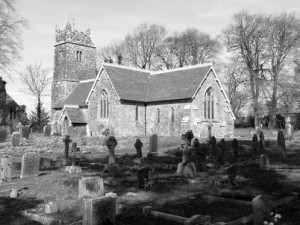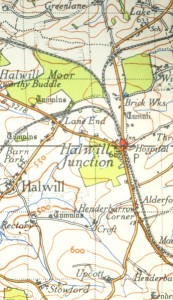William Henry Chadwick was my great great granddad. He was also my brick wall.
 The only information I had of William Henry was anecdotal evidence – my grandmother telling me that he lived with her just before his death in 1937 and that he was born on a ship in Malta in 1853. I also knew from my grandmother that he married a woman called Mary and they had two children, Elizabeth Ann and Clara (my great grandmother), and he had been a coal miner.
The only information I had of William Henry was anecdotal evidence – my grandmother telling me that he lived with her just before his death in 1937 and that he was born on a ship in Malta in 1853. I also knew from my grandmother that he married a woman called Mary and they had two children, Elizabeth Ann and Clara (my great grandmother), and he had been a coal miner.
In 2007, after my grandmother’s death, I decided to start my search for William Henry. As I had been told he was born in Malta, I decided to start my search in the UK censuses. To my surprise, in the 1861 census (the first census after he was born) he was an inmate in the Leeds Industrial and Ragged School. No other details were found of him in the 1871 census, however, he was found on the next four censuses as being born between Malta and Corfu, married to a woman called Mary and had two living children and two children who had died. He died on 13 September 1937 in Leeds although, I had no idea where or even if he was buried. I also had no evidence as to who he married and indeed no birth certificates for his two daughters (one of whom was my great grandmother). While William Henry was a conundrum and I was firmly at a brick wall, I gained a small chink of light when I spoke to my father about this and he then informed me that he possessed William Henry’s original marriage certificate!

Original marriage certificate of William Henry Chadwick to Mary Merriman
The certificate told me that William Henry Chadwick was married in 1877 in a Roman Catholic Church in Stockport to a woman called Mary Merriman. (Why he was in Stockport would remain a mystery until 2014.) The information that he married in a Roman Catholic Church, made me think his children might have also been baptised in a Roman Catholic Church and that he might have been buried in a Roman Catholic cemetery. Acting on this thought, I looked at the records for the local RC cemetery in Leeds (Killingbeck cemetery) and found both William Henry and his wife Mary buried there – both buried in mass graves. Boosted by this find, I decided to look for baptism records in the Roman Catholic churches around the areas William Henry and his family lived when his children were born (Allerton Bywater and Oldham, Lancashire). I could find no record of any baptism records for his children within those parishes. I gave up at this point, feeling that it was an impossible task.
It was three years later, in 2012, when I was looking for members of my surname study, that I viewed the RC baptism records for St Joseph’s in Hunslet Leeds and stumbled upon the baptism for my great grandmother Clara.

Baptismal entry of Clara Chadwick
This spurred me on to look for her sister Elizabeth Ann, which I also found in the same records. After that, I came to a dead halt until the release of the Ancestry West Yorkshire Reformatory School Records in 2014.
I had got into the habit of just putting William Henry’s name into the new records when they came to Ancestry and wasn’t expecting much when I put his name to the West Yorkshire Reformatory School and Prison Records, however, I turned up a little gold mine! In the 1861 census, William Henry was an inmate at the Leeds Ragged School (proved by census records). In 1862, William Henry Chadwick was in front of magistrates in Leeds and was sent to Shadwell reformatory. His crime was “neglected, destitute and sleeping out at night” – he was eight years old. He was “sentenced” to five years at Shadwell reformatory (Ancestry West Yorkshire Reformatory School Records).
The records at Shadwell Reformatory tell a lot about his past background. He could not read, write or understand numbers. His mother was described as a thief and a prostitute who had been convicted over 20 times. It states that both his mother and his stepfather were cruel to him, being up in front of the magistrate seven times for cruelty. His brother fared worse than he did, having been hit around the head with a lead poker. It states that the lads were glad to be taken away.
William was described as an “odd” looking lad, light hair, blue eyes and very thin. He was described as having a peculiar look, walk and gait.
These records also told me his mother was called Margaret Chadwick and he had a brother called George Chadwick. I found Margaret Chadwick and George Chadwick on the 1851 census. Margaret was described as a daughter in law and a soldier’s wife, George was described as a grandson. The head of household was Jeremiah Stead and his wife Keziah. On further examination, this couple were married in 1847 (Ancestry West Yorkshire Marriage Records). Keziah’s previous name was Wrigglesworth, but on her marriage certificate, her father was Isaac CHADWICK. On looking through the Ancestry West Yorkshire Marriage Records, I found Keziah CHADWICK had married Charles Wrigglesworth in 1825. This was the connection between Margaret Chadwick and the Stead family! Looking at the Ancestry West Yorkshire Baptisms from 1805 to 1825 I found Keziah CHADWICK had a son, George, baptised at St Peter’s Church (Hunslet Chapelry) on 17 August 1821. He was illegitimate. This was my great great great granddad. He was the first child of Kezia Chadwick who then went on to have six other children between 1827 and 1839 with her first husband Charles Wrigglesworth. She also had a second husband, Jeremiah Stead.
George Chadwick was a soldier. He enlisted in 1839 into the 68th Regiment of Foot. According to his attestation sheets, George stated he was from Halifax, however, he enlisted in Leeds. During his service he went to Quebec, Ireland, Britain and also to Malta where William Henry was born (this service was confirmed from discharge papers and also from the history of the regiment). As stated, his regiment had been to Ireland. This is where he met and married Margaret McGreal on 3rd March 1848 in Granard, Co. Longford (proved by Irish Civil Registration Index). On the index, it states his father was Samuel Chadwick, a porter – this is disproved by his baptism papers. His first child, George was born in Granard in 1848 (Irish Civil Registration Index).
Looking at his discharge papers, he was in trouble in the army several times, being court martialled four times and committing at least 40 minor crimes. Needless to say, he was not promoted beyond a private. He was discharged from the army on 1 May 1855, having been found unfit for further duty. His final description showed a man of 5 feet 10 inches, he had brown hair with grey eyes, he had a fair complexion and his trade was a labourer. He died of TB on 26 December 1855 at Thwaite Gate, Hunslet (proved by death certificate, death witnessed by Margaret Chadwick, wife). He was buried in Hunslet Cemetery on 30 December 1855 (Yorkshire Indexers Burial Index).
Margaret McGreal, his wife was a thief and a prostitute, there are numerous reports from 1856-1858 of thieving and prostitution (proved by various newspaper reports between the years 1856-1858, one report in particular stating she was a soldiers widow and had two children). A report, in the Leeds Mercury in 1858 states that she had been employed at a forge within the neighbourhood of Thwaite Gate (which is where she was living when her husband died) but she then commenced drinking and led a life of prostitution. She was jailed several times, usually for either days or months. She married John William Sharp in 1858 (proved by marriage certificate on Ancestry West Yorkshire Marriage Records 1815-1935 – and stated at that point that her father was John MOORHOUSE, a farmer – this was untrue, according to her previous marriage record to George Chadwick, her father was Patrick McGreal) and the two children lived with her for a while. George, her eldest son was taken into care in 1859 (stated in William Henry Chadwick’s reformatory School Records) and died, aged 13 in 1860 of TB (as proved by death certificate, informant was the mistress at the children’s home) at a home in Burley (also stated in William Henry Chadwick’s reformatory School Records). He is buried in the cemetery at Burley in Wharfedale (Ancestry West Yorkshire Burial records and also Yorkshire Indexers Burial records).
While William was an inmate at the Shadwell Centre, his mother went on to commit more crimes, ending up in prison (both Leeds and Wakefield prisons) for long periods of time (one period of seven years for stealing 10 pounds in weight of dough, one period of two years for stealing six cauliflowers) and numerous other crimes in between these (as stated in various newspaper articles of the time in the Leeds Mercury and Leeds Times, referring to Margaret as Margaret Sharp formerly Chadwick, and she was also registered in the Ancestry Criminal Registers, for a prison spell of seven years).
William was apprenticed from Shadwell on 22 May 1865, as an apprentice coal miner to a gentleman called Michael Caanan, from Darton, Barnsley (West Yorkshire reformatory records). When he was discharged, he was found to be able to read the bible, have a fair hand at writing and be able to follow simple and complex rules of arithmetic. His character was found to be good and his general knowledge was also good.
In the 1871 census, William was found to be with Michael Caanan in Bloxwich, Staffordshire as a coal miner. He was down in the census as being called William John Chadwick and as Michael Caanan’s nephew. I have found no evidence to state this is true as of yet.
William was discharged from being an apprentice on 16 May 1871, and he went to live with his grandmother Keziah in Cross Gates, Leeds. He was working as a coal miner at the Waterloo Pit, Leeds in 1873, which is the last record from Shadwell there is.
His mother continued to offend right up to her death (once again proved by newspaper reports) and died late in the December quarter of 1890, in the Leeds West Registration District.
William continued to move around the country, going from Stockport where he was married (proved by marriage certificate shown above), back to Leeds, to Oldham, Castleford and finally settling in Leeds (all proved by census records, baptism records of his children and electoral rolls). He and Mary had four children, Clara and Lizzie and two unknown (as recorded in the 1911 census). William died on 13 September 1937 (as proved by death certificate, informant was his daughter Clara Greenhough), aged 84 and is buried in Killingbeck Cemetery in a mass grave.
It was a long but very rewarding search. I found out more about William Henry’s life and life in the 1860s and 1870s than I have done on any of my ancestors. He had a very tough early life however, he fared well after this.
Chris Jordan
September 2015.







